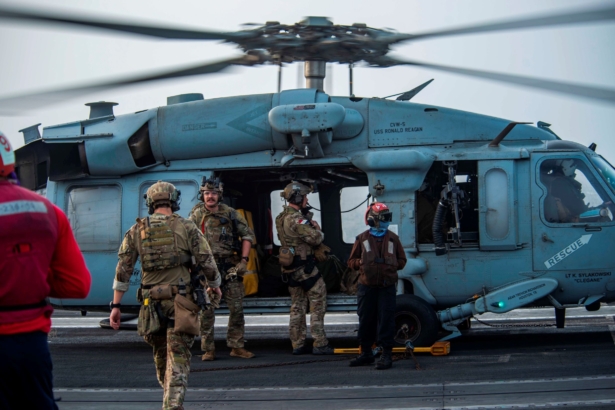All six crew members of a U.S. Navy helicopter miraculously survived as they crashed into Southern Californian waters Thursday night, an army spokesperson has said.
The MH-60R Seahawk crashed into San Diego Bay near Naval Amphibious Base Coronado at around 6:40 p.m. while on a routine training mission, according to Cmdr. Beth Teach of the Naval Air Force Pacific Fleet.
“Due to the nature of the training, a safety boat was on location,” her statement said. The local Fire Department and the U.S. Coast Guard assisted the Navy’s rescue operation.
All six crew members were taken ashore for medical evaluation.
No further details about their condition was relayed, although it was confirmed that no critical or life-threatening injuries had been reported.
“An investigation has been initiated to determine the cause of the crash,” Cmdr. Teach added.
The helicopter belonged to Helicopter Maritime Strike Squadron 41 (HMS-41), which is based at Naval Air Station North Island on the Coronado peninsula.
According to the Navy, HSM-41 is a Fleet Replacement Squadron that trains the Navy’s aspiring aviators and aircrewmen to fly and operate the MH-60R helicopter, which it calls “the world’s most advanced rotary wing maritime strike platform.”
On its website, the Squadron boasts more than 230,000 Class A mishap-free flight hours in its 37-year history, training more than 4,000 pilots and aircrew for service.
The Sikorsky MH-60R is commonly known as a Seahawk helicopter, and is used for anti-submarine warfare, electromagnetic warfare, and surface warfare, according to the U.S. Navy.
The helicopter is also widely used for tasks that include reconnaissance, medical evacuation, and search-and-rescue operations—both military and civilian.

It is not the first time a U.S. military helicopter has crashed during the past year.
In November, five members of the army’s aviation special operations forces lost their lives when their helicopter crashed into the Mediterranean Sea after it “experienced an in-flight emergency” during an aerial refueling training operation.
The same month, a U.S. Navy spy plane crashed into a reef off the Hawaiian island of Oahu. All nine crew members survived, but the Navy is still working on removing the aircraft from a bed of coral and sand.
In August, a V-22 Osprey aircraft went down during a military drill in Canada, killing three Marines and leaving 20 hospitalized. It was the 10th lethal accident involving an Osprey since 1992, bringing the number of fatalities with the contested aircraft to 53.
In March, nine soldiers perished in a collision between two HH60 Black Hawk helicopters from the 101st Airborne Division during a training mission over Kentucky.
A 2020 Military Aviation Safety report identified a lack of adequate flight hours and insufficient personnel training as some of the main reasons behind U.S. military aircraft accidents.


